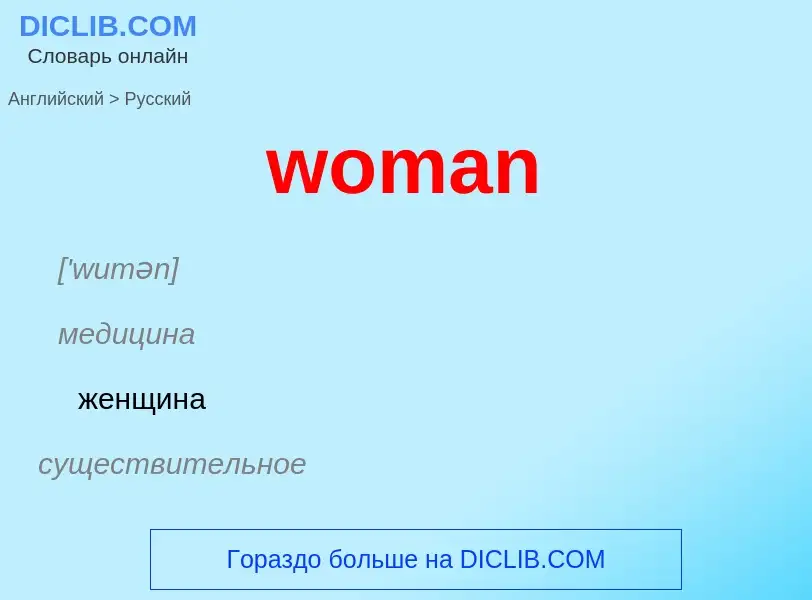Перевод и анализ слов искусственным интеллектом
На этой странице Вы можете получить подробный анализ слова или словосочетания, произведенный с помощью лучшей на сегодняшний день технологии искусственного интеллекта:
- как употребляется слово
- частота употребления
- используется оно чаще в устной или письменной речи
- варианты перевода слова
- примеры употребления (несколько фраз с переводом)
- этимология
WOMAN - перевод на Английский
['wumən]
медицина
женщина
существительное
общая лексика
женщина
(the woman) типичная женщина
воплощение женственности
женского начала
любовница
приятельница (юноши, мужчины)
женщина какой-л. профессии (обыкн. в сочетаниях)
работница
служанка
женственный мужчина, 'баба'
(без артикля) женщины, женский пол
(the woman) женственность, женское начало
служанка, уборщица
женский
собирательное выражение
женщины
женский пол
презрительное выражение
баба (о мужчине)
диалектизм
жена
грубое выражение
баба
существительное
общая лексика
Всемирная организация матерей
синоним
['wumən]
общая лексика
"Вуман" (еженедельный иллюстрированный журнал для женщин; печатает рассказы и романы с продолжением, обыкн. сентиментального характера, практические советы для хозяек и т.п.; тир. ок. 1,5 млн. экз.; издаётся в Лондоне. Основан в 1937)
Определение
Красивая, миловидная девушка, молодая женщина.
Википедия
.jpg?width=120)
A woman is an adult female human. Prior to adulthood, a female human is referred to as a girl (a female child or adolescent). The plural women is sometimes used in certain phrases such as "women's rights" to denote female humans regardless of age.
Typically, women inherit a pair of X chromosomes, one from each parent, and are capable of pregnancy and giving birth from puberty until menopause. More generally, sex differentiation of the female fetus is governed by the lack of a present, or functioning, SRY-gene on either one of the respective sex chromosomes. Female anatomy is distinguished from male anatomy by the female reproductive system, which includes the ovaries, fallopian tubes, uterus, vagina, and vulva. An adult woman generally has a wider pelvis, broader hips, and larger breasts than an adult man. Women have significantly less facial and other body hair, have a higher body fat composition, and are on average shorter and less muscular than men.
Throughout human history, traditional gender roles have often defined and limited women's activities and opportunities, resulting in gender inequality; many religious doctrines and legal systems stipulate certain rules for women. With restrictions loosening during the 20th century in many societies, women have gained access to careers beyond the traditional homemaker, and the ability to pursue higher education. Violence against women, whether within families or in communities, has a long history and is primarily committed by men. Some women are denied reproductive rights. The movements and ideologies of feminism have a shared goal of achieving gender equality.
Trans women have a gender identity that does not align with their male sex assignment at birth, while intersex women may have sex characteristics that do not fit typical notions of female biology.

.jpg?width=200)

![Women attending an adult literacy class in the [[El Alto]] section of [[La Paz]], [[Bolivia]] Women attending an adult literacy class in the [[El Alto]] section of [[La Paz]], [[Bolivia]]](https://commons.wikimedia.org/wiki/Special:FilePath/Bolivia la paz literacy LOC.jpg?width=200)
![A campaign against [[female genital mutilation]] – a road sign near [[Kapchorwa]], [[Uganda]] A campaign against [[female genital mutilation]] – a road sign near [[Kapchorwa]], [[Uganda]]](https://commons.wikimedia.org/wiki/Special:FilePath/Campaign road sign against female genital mutilation (cropped).jpg?width=200)
![German composer [[Clara Schumann]] in 1878 German composer [[Clara Schumann]] in 1878](https://commons.wikimedia.org/wiki/Special:FilePath/Franz von Lenbach - Clara Schumann (Pastell 1878).jpg?width=200)
![nursing]] an infant nursing]] an infant](https://commons.wikimedia.org/wiki/Special:FilePath/Kabala mother.jpg?width=200)




![A poster from a 1921 [[eugenics]] conference displays the U.S. states that had implemented sterilization legislation. A poster from a 1921 [[eugenics]] conference displays the U.S. states that had implemented sterilization legislation.](https://commons.wikimedia.org/wiki/Special:FilePath/Sterilization states.jpg?width=200)

